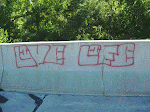Found a shrink-wrapped video of RKO Pictures’ Fighting Father Dunne (1948) starring Pat O’Brien, the story of how Father Peter J.
Dunne (d. 1939) in the early 1900s founded a home for homeless newsboys and
cleverly obtained a building, money, beds, a housekeeper, and a pony
to keep it going, by sweet-talking and hiring lots of Irish-born people. It’s a
good movie except for its ending, which is probably entirely fictional.
The references to St. Louis locations are correct, and
then-Archbishop Glennon is portrayed as having a severe manner but a big heart.
The movie indicates that the newspapers were supposed to be caring for their
newsboys. But they weren’t.
 Father Dunne’s Newsboys Home and Protectorate expanded to include
a camp. The Archdiocese of St. Louis can tell me only that the camp
was established in 1941, the same year the property was acquired, two years after
Father Dunne’s death. Boys first came to camp here on August 8, 1941, according
to a letter held by the Archdiocese. A dorm was built and dedicated in 1957. The Archdiocese has no further information, nor do they have photos, maps, or other images.
But I have some images.
Father Dunne’s Newsboys Home and Protectorate expanded to include
a camp. The Archdiocese of St. Louis can tell me only that the camp
was established in 1941, the same year the property was acquired, two years after
Father Dunne’s death. Boys first came to camp here on August 8, 1941, according
to a letter held by the Archdiocese. A dorm was built and dedicated in 1957. The Archdiocese has no further information, nor do they have photos, maps, or other images.
But I have some images.
Pat O'Brien does NOT wink like that in the movie.













